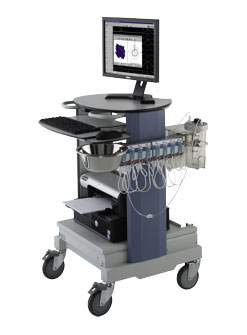Understanding Esophageal Manometr
The Esophagus
The esophagus is a muscular tube that connects your throat to your stomach. With each swallow, the esophagus muscle contracts and pushes food into the stomach. At the lower end of the esophagus, a valve (a special sphincter muscle) remains closed except when food or liquid is swallowed or when you belch or vomit.
What is esophageal testing, also called manometry, and why is it performed? Esophageal testing or manometry measures the pressures and the pattern of muscle contractions in your esophagus. Abnormalities in the contractions and strength of the muscle or in the sphincter at the lower end of the esophagus can result in pain, heartburn, and/or difficulty swallowing. Esophageal manometry is used to diagnose the conditions that can cause these symptoms.

An empty stomach allows for the best and safest examination, so do not eat or drink anything for 6 hours before the test. Since many medications can affect esophageal pressure and the natural muscle contractions required for swallowing, be sure to discuss with your healthcare professional each medication you are taking. Your doctor may ask that you temporarily stop taking one or more medications before your test.
A healthcare professional will apply a cream to numb the inside of your nostrils. Then a thin, flexible, lubricated tube will be passed through your nose and advanced into your stomach while you swallow sips of water. Mild, brief gagging may occur while the tube is passed through the throat. When the tube is in position, you will be sitting upright or lying on your back while the tube is connected to a computer. Once the test begins it is important to breathe slowly and smoothly, remain as quiet as possible and avoid swallowing unless instructed to do so. As the tube is slowly pulled out of your esophagus, the computer measures and records the pressures in different parts of your esophagus.
During the test, you may experience some discomfort in your nose and/or throat. The test will take approximately 30 minutes to complete and the results will be sent to your doctor’s office.
Anorectal manometry is a test performed to evaluate patients with constipation or fecal incontinence. This test measures the pressures of the anal sphincter muscles, the sensation in the rectum, and the neural reflexes that are needed for normal bowel movements.
The test takes approximately 30 minutes. You will be asked to change into a hospital gown. A technician or nurse will explain the procedure to you, take a brief health history, and answer any questions you may have. The patient then lies on his or her left side. A small, flexible tube, about the size of a thermometer, with a balloon at the end is inserted into the rectum. The catheter is connected to a machine that measures the pressure. During the test, the small balloon attached to the catheter may be inflated in the rectum to assess the normal reflex pathways. The nurse or technician may also ask the person to squeeze, relax, and push at various times. The anal sphincter muscle pressures are measured during each of these maneuvers. To squeeze, the patient tightens the sphincter muscles as if trying to prevent anything from coming out. To push or bear down, the patient strains down as if trying to have a bowel movement. Two other tests may be done: first, an anal sphincter electromyography (EMG), a test to evaluate the nerve supply to the anal muscle; second, measurement of the time it takes to expel a balloon from the rectum. After the examination, you may drive yourself home and go about your normal activities.
Anal sphincter electromyography (EMG) is recorded with a small plug electrode placed in the anal canal. The patient then is asked to relax, squeeze and push at different times. The anal sphincter muscle electrical activity is recorded and displayed on a computer screen.
Anal sphincter EMG confirms the proper muscle contractions during squeezing and muscle relaxation during pushing. In people who paradoxically contract the sphincter and pelvic floor muscles, the tracing of electrical activity increases, instead of decreasing, during bearing down to simulate a bowel movement (defecation).
Normal anal EMG activity with low anal squeeze pressures on manometry may indicate a torn sphincter muscle that could be repaired.
For this procedure, a small balloon is inserted into the rectum and then inflated with water. The patient goes to the bathroom and tries to defecate (expel) the small balloon from the rectum. The amount of time it takes to expel the balloon is recorded. Prolonged balloon expulsion suggests a dysfunction in the anorectum area.
Anorectal manometry is a safe, low risk procedure and is unlikely to cause any pain. Complications are rare: it is possible that a perforation (tearing) or bleeding of the rectum could occur. Equipment failure is a remote possibility. If you are allergic to latex, you should inform the nurse/technician before the test so that a latex free balloon can be used.